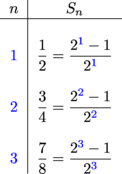We can use the idea of partial sums to (finally) describe what it means to add infinitely many numbers together. We can taste our infinite brownie, too. In symbols, we want to know what

means, and just how much chocolaty goodness we're going to get.
Think about what happens when you put laundry detergent into a washing machine. As you add more suds, there's enough to wash the laundry and all goes well. You can also add so much that a detergent monster oozes from the washer, soaping your dry socks and cat Binx.
The same happens with series. As we add numbers, if the sum gets closer and closer to some particular value L, this means the partial sums
S1, S2, S3, ...
get closer and closer to L. In this case, it makes sense to say that when we add those infinitely many numbers together, we get L.
If the sum doesn't get closer and closer to any particular number as we keep adding and adding, there's no reasonable way to say what the sum of those infinitely many numbers is. The series is an untamable detergent beast.
Since we promised food, we can put this in terms of a brownie, or a brownie and limits. Specifically, we're talking about the limit of the sequence of partial sums.
Start with a series and look at the associated sequence of partial sums
S1, S2, S3, ....
As with any sequence, this sequence may converge or diverge.
If the sequence of partial sums converges to a finite number L, then we say the series converges to L. In symbols, the series converges to L if there's a finite number L with

In this case we say that L is the sum of the series.
If the sequence of partial sums doesn't converge, then the series doesn't converge either, and we say the series diverges.
In terms of a brownie, if our brownie continues to grow so large that it won't fit inside any box, then the brownie is infinite. But if there is a box it will fit inside of, the brownie is finite in size.
Be Careful: From here on, we're using the word converge to mean three or four different things.
The word converge means different things depending on whether we're talking about sequences, series, functions, or improper integrals.
- When talking about sequences, we use the word "converge" to mean the terms of the sequence
a1, a2, a3, ...
approach a limit.
- When talking about series, we use the word "converge" to mean the terms of the sequence of partial sums
S1, S2, S3, ...
approach a limit.
Finding the sum of a series can be difficult, because not every series has a nice formula for the partial sum, Sn. Fortunately, we often only care if a series converges or diverges. That's much easier than finding the exact sum. We'll see later that we have a number of tools in a handy, leather tool belt to help us figure these things out.
The finite series
3 + 4
can be rewritten as the infinite series
3 + 4 + 0 + 0 + 0 + 0 + ...
The partial sums of this series are
S1 = 3
S2 = 7
S3 = 7
and Sn = 7 for all larger n. The sequence of partial sums is
3, 7, 7, 7, 7, 7,...
Since the sequence of partial sums converges to 7, it makes sense to say that the series
3 + 4
converges to 7.
Example 1
Determine if the series
from Zeno's Paradox diverges or converges. If it converges, what is the sum of the series? |
Example 2
Determine if the series
converges or diverges. If it converges, find its sum. |













